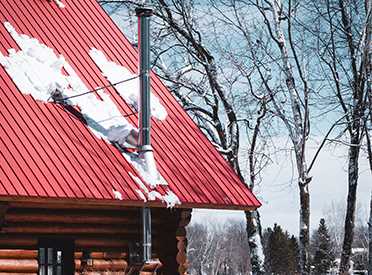How to choose the right wood stove?
To choose the right wood stove, you must first consider a few elements, then calculate the theoretical and real heating area to target the appliance that suits your needs.
- Where is the wood stove installed?
As heat rises, an appliance located in the basement will radiate heat towards the first floor. However, an appliance located on the first floor will not heat to the basement. This principle also applies to high or cathedral ceilings, that cause a certain quantity of heat will be lost. - Does the heat flow easily?
A space with a large number of divisions will be more difficult to heat because it will be more complex to distribute the heat. Open areas and rooms near the appliance will be the easiest to heat. Keep in mind that a wood stove is not a main heating system, it is an additional heating source. Some accessories such as blowers can help distribute the hot air, but a wood furnace remains the most efficient solution for heating a house evenly. - How effective is your insulation?
The better a home is insulated, the more heat is retained inside it. The number, type and orientation of doors and windows as well as the thermal resistance of the walls influence the level of insulation of your home. - How do you want to use the wood stove?
A sustained use is defined as an additional heating source that provides maximum heat. An ambiance use is defined as a source of heat which provides a warm environment mainly around the appliance.
The theoretical heating area
The theoretical area is the basic measurement used to then calculate the real area to be heated. Calculate 100% of the area of the floor on which the appliance is installed, plus 50% of the floor above, plus 25% of the next floor, if there is one.
For example, a wood stove installed in the basement of an 800 ft² 2-storey house will provide 1,400 ft² of theoretical heating area.
Theoretical area to be heated = 100% floor 1 + 50% floor 2 + 25% floor 3
= 800 ft² + 400 ft² + 200 ft²
= 1400 ft²
The real heating area
To obtain the real heating area, simply add a comfort margin to the theoretical heating area to adjust it to the conditions in which the wood stove will be used. Remember that other factors such as humidity, wood quality, chimney and weather will influence the performance of your appliance on a daily basis.
For example:
- for a theoretical heating area of 1,400 ft² with very favorable conditions (ambiance use, good insulation, good air circulation): it is recommended to slightly exceed the theoretical heating area and to aim for a real heating area of 1,600 ft².
- for the same theoretical heating area, but with less favorable conditions (sustained use, less insulation, less air circulation): it is recommended to add a greater margin of comfort and to aim for a real heating area of 1,800 ft², or even 2,000 ft².
There are three main benefits to a more powerful unit: increased heating capacity, ease of loading longer or larger logs, and longer burn time. But beware! When a wood stove is too large, it is common to compensate by frequently doing smaller fires, which makes the appliance less efficient and generates more creosote. Conversely, when a wood stove is too small, it is common to compensate by frequently using the appliance at its maximum capacity, which risks wearing it out prematurely.

